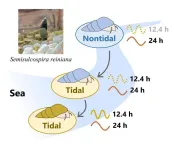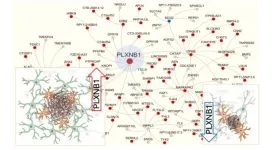(Press-News.org) Organisms, including humans, follow a schedule that coordinates important bodily functions such as sleep-wake cycles, metabolism, hormone production, cognitive function, and feeding habits to environmental cycles. While most organisms possess circadian rhythms synchronized with the 24-hour day-night cycle, they have also developed other internal clocks to suit their local environments. Marine animals have evolved circatidal rhythms, aligning activities with the 12.4-hour tidal cycle, complementing circadian rhythms.
Researchers from Chiba University have discovered that snails living in downstream tidal areas have biological rhythms synchronized with the tidal cycles, unlike those in nontidal regions. This observation raises the question of whether circatidal rhythms develop due to differences in habitat or are caused by genetic variations between the populations.
Building on their previous findings, Associate Professor Yuma Takahashi, along with Dr. Takumi Yokomizo from Chiba University (at the time of the study, and currently a post-doc researcher at the Center for Ecological Research, Kyoto University), revealed that freshwater snails living in tidal environments gradually adjust their biological rhythms to synchronize with the tidal cycles. The study published in the journal Heredity on March 27, 2024, offers insights into the adaptability and potential divergence of biological rhythms in response to tidal environments.
“This study revealed genetic and non-genetic changes in biological rhythms while adapting to tidal environments in a freshwater snail. This result could lead to an understanding of the role of biological clocks in the adaptation to rhythmic environment, which is one of the most important issues in chronobiology,” says Dr. Takahashi. The researchers collected freshwater snails (Semisulcospira reiniana) from tidal and nontidal areas along the Kiso River in Japan, 20 km apart. Snails were divided into two groups: one exposed to a regular 24-hour light-dark cycle, while the other experienced a simulated 12-hour tidal cycle, alternating between submersion during high tide and exposure to air during low tide.
Following a 4-week entrainment period, the researchers analyzed the behavior and genetic expression patterns of the snails in darkness at a constant temperature of 23°C. Among the snails from non-tidal areas, there were no significant differences in the intensity of the circadian and circatidal rhythms between the two groups. However, snails from tidal areas that were exposed to the simulated tidal cycle showed stronger circatidal rhythms compared to the control group. Interestingly, both the tidal and non-tidal populations exposed to the simulated tide showed an increase in the number of circatidal oscillating genes and a decrease in the circadian oscillating genes (genes that fluctuate in activity in tune with the tidal and diurnal cycle, respectively). Snails that had already adapted to the tidal cycles in the rivers in their early life had a greater number of circatidal oscillating genes compared to the nontidal population.
These results imply that the expression rhythms of genes controlled by the biological clock are sensitive to environmental changes, and can be influenced by genetic changes that result from environmental adaptation. “Our study focused on the flexibility of biological clocks and found their potential to change biological rhythms according to dominant environmental cycles,” says Dr. Takahashi.
Disruptions to biological rhythms can negatively impact various physiological processes. The findings of this study may enhance our understanding of how organisms adapt to changing environmental conditions and prove valuable in the treatment of chronobiological diseases in the future.
About Associate Professor Yuma Takahashi from Chiba University
Dr. Yuma Takahashi is an Associate Professor at the Graduate School of Science, Chiba University. He has a Ph.D. from the University of Tsukuba and has held research fellowships at the University of Tsukuba and Tohoku University. His research focuses on integrating hierarchies and time scales and includes topics like gene expression variation, developmental fluctuations, phenotypic plasticity, and rapid adaptation. Dr. Takahashi has published numerous articles on damselflies, Drosophila, and freshwater snails, exploring the genetic and environmental factors shaping their evolutionary trajectories. He has won numerous awards, including the Miyaji Award from the Ecological Society of Japan and the Population Ecology Young Scientist Award.
END
Investigating the origin of circatidal rhythms in freshwater snails
Snails synchronize rhythms with tides, revealing adaptability to environmental changes
2024-05-27
ELSE PRESS RELEASES FROM THIS DATE:
Altering cellular interactions around amyloid plaques may offer novel Alzheimer’s treatment strategies
2024-05-27
New York City, [May 27, 2024] – Researchers at the Icahn School of Medicine at Mount Sinai have made a significant breakthrough in Alzheimer’s disease research by identifying a novel way to potentially slow down or even halt disease progression. The study, which focuses on the role of reactive astrocytes and the plexin-B1 protein in Alzheimer's pathophysiology, provides crucial insights into brain cell communication and opens the door to innovative treatment strategies. It was published in Nature Neuroscience (DOI 10.1038/s41593-024-01664-w) on May 27.
This groundbreaking work is centered ...
Brain damage reveals part of the brain necessary for helping others
2024-05-27
Our willingness to help others is governed by a specific brain region pinpointed by researchers in a study of patients with brain damage to that region.
Learning about where in the brain ‘helping’ decisions are made is important for understanding how people might be motivated to tackle large global challenges, such as climate change, infectious disease and international conflict. It is also essential for finding new approaches to treating disorders of social interactions.
The study, ...
Surprising properties of elastic turbulence discovered
2024-05-27
Blood, lymph fluid and other biological liquids can have surprising and sometimes troubling properties. Many of these biological solutions are non-Newtonian fluids, a type of liquid that is characterized by a non-linear relationship between stress and strain. Consequently, non-Newtonian fluids don’t necessarily behave as one would expect from a liquid. For example, some of these peculiar fluids deform when touched lightly but will act almost as a solid when a strong force is applied.
And biological ...
Study assesses cancer-related care at US hospitals predominantly serving minority populations compared with non-minority serving hospitals
2024-05-27
It’s important to ensure that care provided at US hospitals that predominantly serve Black and Hispanic populations is as high-quality as the care provided at other US hospitals. New research reveals significant disparities in the delivery of cancer-related care at minority serving hospitals (MSHs) compared with non-MSHs, however. The findings are published by Wiley online in CANCER, a peer-reviewed journal of the American Cancer Society.
For the study, investigators analyzed information from the National Cancer Database (which accrues approximately 70% of US cancer diagnoses) to identify patients eligible for definitive ...
First in-human investigator-initiated clinical trial to launch for refractory prostate cancer patients: Novel alpha therapy targets prostate-specific membrane antigen
2024-05-27
Osaka, Japan - A research team at Osaka University will start an investigator-initiated clinical trial for refractory prostate cancer patients after successful development of a new alpha-ray therapeutic agent ([At-211] PSMA-5) and confirmation of its efficacy in animal models. This will be a world-first in-human clinical trial with [At-211] PSMA-5.
Prostate cancer is on the rise worldwide and is the most commonly diagnosed new cancer in men in Japan. Various treatments are offered for prostate cancer, but the prognosis is very poor when the disease is resistant to standard treatment and associated with multiple metastases.
In ...
Will generative AI change the way universities communicate?
2024-05-27
Since the launch of ChatGPT 3 in November 2022, we've been abuzz with talk of artificial intelligence: is it an unprecedented opportunity, or will it rob everyone of jobs and creativity? As we debate on social media (and perhaps use ChatGPT almost daily), generative AIs have also entered the arena of university communication. These tools—based on “Large Language Models” that were optimized for interactive communication—can indeed support, expand, and innovate university communication ...
Artificial Intelligence could help cure loneliness, says expert
2024-05-27
Artificial Intelligence (AI) technology could offer companionship to lonely people amid an international epidemic of loneliness, says a robotics expert.
Tony Prescott, a professor of cognitive robotics at the University of Sheffield, argues in his new book The Psychology of Artificial Intelligence that ‘relationships with AIs could support people’ with forms of social interaction..
Loneliness has been found to seriously impair human health, and Professor Prescott makes a case that advances in AI technology could ...
Echidnapus identified from an ‘Age of Monotremes’
2024-05-26
Published today in the Alcheringa: An Australasian Journal of Palaeontology, evidence of an ‘Age of Monotremes’ has been unearthed by a team of Australian scientists at the Australian Museum (AM), Museums Victoria and Australian Opal Centre.
The findings were led by two renowned mammalogists, Honorary Associate of the Australian Museum, Professor Tim Flannery; and Professor Kris Helgen, Chief Scientist and Director of the Australian Museum Research Institute (AMRI).
Found in the Lightning Ridge opal fields, NSW, the opalised jaws ...
Semaglutide may protect kidney function in individuals with overweight or obesity and cardiovascular disease
2024-05-25
The SELECT Trial has revealed the potential of semaglutide, a glucagon-like peptide-1 (GLP-1) receptor agonist, in combating kidney function decline among individuals with overweight or obesity and established cardiovascular disease but without diabetes.1
Unveiling the results today at the 61st ERA Congress, researchers presented the impressive secondary analysis from the SELECT (Semaglutide Effects on Heart Disease and Stroke in Patients with Overweight or Obesity) trial, a randomised trial comprising a participant pool of 17,604 individuals.
Experts believe the study’s results offer hope for those affected by obesity, a condition known ...
New technique detects novel biomarkers for kidney diseases with nephrotic syndrome
2024-05-25
A groundbreaking study, presented today at the 61st ERA Congress, has uncovered a significant breakthrough in the diagnosis and monitoring of kidney diseases associated with nephrotic syndrome.1
Using a hybrid technique, researchers identified anti-nephrin autoantibodies as a reliable biomarker for tracking disease progression, opening new avenues for personalised treatment approaches.
Nephrotic syndrome, characterised by elevated protein levels in the urine, is linked to kidney diseases such as minimal change disease (MCD), primary focal segmental glomerulosclerosis (FSGS), and membranous nephropathy (MN). The primary cause behind nephrotic syndrome is damage to podocytes, the ...
LAST 30 PRESS RELEASES:
American Meteorological Society announces Rick Spinrad as 2026 President-Elect
Biomass-based carbon capture spotlighted in newly released global climate webinar recording
Illuminating invisible nano pollutants: advanced bioimaging tracks the full journey of emerging nanoscale contaminants in living systems
How does age affect recovery from spinal cord injury?
Novel AI tool offers prognosis for patients with head and neck cancer
Fathers’ microplastic exposure tied to their children’s metabolic problems
Research validates laboratory model for studying high-grade serous ovarian cancer
SIR 2026 delivers transformative breakthroughs in minimally invasive medicine to improve patient care
Stem Cell Reports most downloaded papers of 2025 highlight the breadth and impact of stem cell research
Oxford-led study estimates NHS spends around 3% of its primary and secondary care budget on the health impacts of heat and cold in England
A researcher’s long quest leads to a smart composite breakthrough
Urban wild bees act as “microbial sensors” of city health.
New study finds where you live affects recovery after a hip fracture
Forecasting the impact of fully automated vehicle adoption on US road traffic injuries
Alcohol-related hospitalizations from 2016 to 2022
Semaglutide and hospitalizations in patients with obesity and established cardiovascular disease
Researchers ‘listen in’ to embryo-mother interactions during implantation using a culture system replicating the womb lining
How changing your diet could help save the world
How to make AI truly scalable and reliable for real-time traffic assignment?
Beyond fragmented markets: A new framework for efficient and stable ride-pooling
Can shape priors make road perception more reliable for autonomous driving?
AI tracks nearly 100 years of aging research, revealing key trends and gaps
Innovative techniques enable Italy’s first imaging of individual trapped atoms
KIER successfully develops Korea-made “calibration thermoelectric module” for measuring thermoelectric device performance
Diversifying US Midwest farming for stability and resilience
Emphasizing immigrants’ deservingness shifts attitudes
Japanese eels, climate change, and river temperature
Pusan National University researchers discover faster, smarter heat treatment for lightweight magnesium metals
China’s 2024 Gastroenterology Report: marked progress in endoscopy quality and disease management
Pusan National University researchers uncover scalable method for ultrahigh-resolution quantum dot displays
[Press-News.org] Investigating the origin of circatidal rhythms in freshwater snailsSnails synchronize rhythms with tides, revealing adaptability to environmental changes






